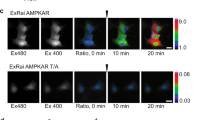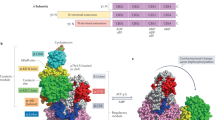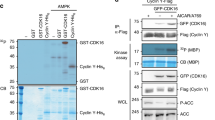Abstract
Maintaining sufficient levels of ATP (the immediate source of cellular energy) is essential for the proper functioning of all living cells. As a consequence, cells require mechanisms to balance energy demand with supply. In eukaryotic cells the AMP-activated protein kinase (AMPK) cascade has an important role in this homeostasis. AMPK is activated by a fall in ATP (concomitant with a rise in ADP and AMP), which leads to the activation of catabolic pathways and the inhibition of anabolic pathways. Here we review the role of AMPK as an energy sensor and consider the recent finding that ADP, as well as AMP, causes activation of mammalian AMPK. We also review recent progress in structural studies on phosphorylated AMPK that provides a mechanism for the regulation of AMPK in which AMP and ADP protect it against dephosphorylation. Finally, we briefly survey some of the outstanding questions concerning the regulation of AMPK.
This is a preview of subscription content, access via your institution
Access options
Subscribe to this journal
Receive 12 print issues and online access
$259.00 per year
only $21.58 per issue
Buy this article
- Purchase on Springer Link
- Instant access to full article PDF
Prices may be subject to local taxes which are calculated during checkout



Similar content being viewed by others
References
Boyer, P.D. et al. Oxidative phosphorylation and photophosphorylation. Annu. Rev. Biochem. 46, 955–966 (1977).
Carling, D., Zammit, V.A. & Hardie, D.G. A common bicyclic protein kinase cascade inactivates the regulatory enzymes of fatty acid and cholesterol biosynthesis. FEBS Lett. 223, 217–222 (1987).
Hardie, D.G., Carling, D. & Sim, A.T.R. The AMP-activated protein kinase: a multisubstrate regulator of lipid metabolism. Trends Biochem. Sci. 14, 20–23 (1989).
Carlson, C.A. & Kim, K.H. Regulation of hepatic acetyl-CoA carboxylase by phosphorylation and dephosphorylation. J. Biol. Chem. 248, 378–380 (1973).
Yeh, L.A., Lee, K. & Kim, K. Regulation of rat liver acetyl-CoA carboxylase. Regulation of phosphorylation and inactivation of acetyl-CoA carboxylase by adenylate energy charge. J. Biol. Chem. 255, 2308–2314 (1980).
Beg, Z.H., Allmann, D.W. & Gibson, D.M. Modulation of 3-hydroxy-3-methylglutaryl coenzyme A reductase activity with cAMP and wth protein fractions of rat liver cytosol. Biochem. Biophys. Res. Commun. 54, 1362–1369 (1973).
Harwood, H.J. Jr., Brandt, K.G. & Rodwell, V.W. Allosteric activation of rat liver cytosolic 3-hydroxy-3-methylglutaryl coenzyme A reductase kinase by nucleoside diphosphates. J. Biol. Chem. 259, 2810–2815 (1984).
Ingebritsen, T.S., Parker, R.A. & Gibson, D.M. Regulation of liver hydroxymethylglutaryl-CoA reductase by a bicyclic phosphorylation system. J. Biol. Chem. 256, 1138–1144 (1981).
Hardie, D.G., Carling, D. & Carlson, M. The AMP-activated/SNF1 protein kinase subfamily: metabolic sensors of the eukaryotic cell? Annu. Rev. Biochem. 67, 821–855 (1998).
Munday, M.R., Campbell, D.G., Carling, D. & Hardie, D.G. Identification by amino acid sequencing of three major regulatory phosphorylation sites on rat acetyl-CoA carboxylase. Eur. J. Biochem. 175, 331–338 (1988).
Cantó, C. & Auwerx, J. AMP-activated protein kinase and its downstream transcriptional pathways. Cell. Mol. Life Sci. 67, 3407–3423 (2010).
Jansen, M., Ten Klooster, J.P., Offerhaus, G.J. & Clevers, H. LKB1 and AMPK family signaling: the intimate link between cell polarity and energy metabolism. Physiol. Rev. 89, 777–798 (2009).
Kahn, B.B., Alquier, T., Carling, D. & Hardie, D.G. AMP-activated protein kinase: Ancient energy gauge provides clues to modern understanding of metabolism. Cell Metab. 1, 15–25 (2005).
Lage, R., Diéguez, C., Vidal-Puig, A. & López, M. AMPK: a metabolic gauge regulating whole-body energy homeostasis. Trends Mol. Med. 14, 539–549 (2008).
Steinberg, G.R. & Kemp, B.E. AMPK in health and disease. Physiol. Rev. 89, 1025–1078 (2009).
Viollet, B. et al. AMPK inhibition in health and disease. Crit. Rev. Biochem. Mol. Biol. 45, 276–295 (2010).
Zhang, B.B., Zhou, G. & Li, C. AMPK: an emerging drug target for diabetes and the metabolic syndrome. Cell Metab. 9, 407–416 (2009).
Carling, D. et al. Mammalian AMP-activated protein kinase is homologous to yeast and plant protein kinases involved in the regulation of carbon metabolism. J. Biol. Chem. 269, 11442–11448 (1994).
Mitchelhill, K.I. et al. Mammalian AMP-activated protein kinase shares structural and functional homology with the catalytic domain of yeast Snf1 protein kinase. J. Biol. Chem. 269, 2361–2364 (1994).
Stapleton, D. et al. Mammalian AMP-activated protein kinase subfamily. J. Biol. Chem. 271, 611–614 (1996).
Carlson, M., Osmond, B. & Botstein, D. Mutants of yeast defective in sucrose utilization. Genetics 98, 25–40 (1981).
Carlson, M., Osmond, B., Neigeborn, L. & Botstein, D. A suppressor of SNF1 mutations causes constitutive high-level invertase synthesis in yeast. Genetics 107, 19–32 (1984).
Celenza, J.L. & Carlson, M. A yeast gene that is essential for release from glucose repression encodes a protein kinase. Science 233, 1175–1180 (1986).
Stapleton, D. et al. Mammalian 5′-AMP–activated protein kinase non-catalytic subunits are homologs of proteins that interact with yeast Snf1 protein kinase. J. Biol. Chem. 269, 29343–29346 (1994).
Woods, A. et al. Characterization of AMP-activated protein kinase beta and gamma subunits. Assembly of the heterotrimeric complex in vitro. J. Biol. Chem. 271, 10282–10290 (1996).
Carlson, M. Glucose repression in yeast. Curr. Opin. Microbiol. 2, 202–207 (1999).
Hardie, D.G. Role of the AMP-activated protein kinase in the metabolic syndrome and in heart disease. FEBS Lett. 582, 81–89 (2008).
Carling, D., Clarke, P.R., Zammit, V.A. & Hardie, D.G. Purification and characterisation of the AMP-activated protein kinase. Eur. J. Biochem. 186, 129–136 (1989).
Neumann, D., Woods, A., Carling, D., Wallimann, T. & Schlattner, U. Mammalian AMP-activated protein kinase: functional, heterotrimeric complexes by co-expression of subunits in Escherichia coli. Protein Expr. Purif. 30, 230–237 (2003).
Beg, Z.H., Stonik, J.A. & Brewer, H.B. Jr. Characterization and regulation of reductase kinase, a protein kinase that modulates the enzymic activity of 3-hydroxy-3-methylglutaryl-coenzyme A reductase. Proc. Natl. Acad. Sci. USA 76, 4375–4379 (1979).
Davies, S.P., Helps, N.R., Cohen, P.T. & Hardie, D.G. 5′-AMP inhibits dephosphorylation, as well as promoting phosphorylation, of the AMP-activated protein kinase. Studies using bacterially expressed human protein phosphatase-2C α and native bovine protein phosphatase-2AC. FEBS Lett. 377, 421–425 (1995).
Hawley, S.A. et al. 5′-AMP activates the AMP-activated protein kinase cascade and Ca2+/calmodulin activates the calmodulin-dependent protein kinase-I cascade, via 3 independent mechanisms. J. Biol. Chem. 270, 27186–27191 (1995).
Hardie, D.G. & Carling, D. The AMP-activated protein kinase—fuel gauge of the mammalian cell? Eur. J. Biochem. 246, 259–273 (1997).
Hawley, S.A. et al. Characterization of the AMP-activated protein kinase kinase from rat liver and identification of threonine 172 as the major site at which it phosphorylates AMP-activated protein kinase. J. Biol. Chem. 271, 27879–27887 (1996).
Sanders, M.J., Grondin, P.O., Hegarty, B.D., Snowden, M.A. & Carling, D. Investigating the mechanism for AMP activation of the AMP-activated protein kinase cascade. Biochem. J. 403, 139–148 (2007).
Suter, M. et al. Dissecting the role of AMP for allosteric stimulation, activation and deactivation of AMP-activated protein kinase. J. Biol. Chem. 281, 32207–32216 (2006).
Hong, S.P., Leiper, F.C., Woods, A., Carling, D. & Carlson, M. Activation of yeast Snf1 and mammalian AMP-activated protein kinase by upstream kinases. Proc. Natl. Acad. Sci. USA 100, 8839–8843 (2003).
Sutherland, C.M. et al. Elm1p is one of three upstream kinases for the Saccharomyces cerevisiae SNF1 complex. Curr. Biol. 13, 1299–1305 (2003).
Hawley, S.A. et al. Complexes between the LKB1 tumor suppressor, STRAD α/β and MO25 α/β are upstream kinases in the AMP-activated protein kinase cascade. J. Biol. 2, 28 (2003).
Woods, A. et al. LKB1 is the upstream kinase in the AMP-activated protein kinase cascade. Curr. Biol. 13, 2004–2008 (2003).
Hawley, S.A. et al. Calmodulin-dependent protein kinase kinase-β is an alternative upstream kinase for AMP-activated protein kinase. Cell Metab. 2, 9–19 (2005).
Woods, A. et al. Ca2+/calmodulin-dependent protein kinase kinase-β acts upstream of AMP-activated protein kinase in mammalian cells. Cell Metab. 2, 21–33 (2005).
Stahmann, N., Woods, A., Carling, D. & Heller, R. Thrombin activates AMP-activated protein kinase in endothelial cells via a pathway involving Ca2+/calmodulin-dependent protein kinase kinase β. Mol. Cell. Biol. 26, 5933–5945 (2006).
Tamás, P. et al. Regulation of the energy sensor AMP-activated protein kinase by antigen receptor and Ca2+ in T lymphocytes. J. Exp. Med. 203, 1665–1670 (2006).
Thornton, C., Sardini, A. & Carling, D. Muscarinic receptor activation of AMP-activated protein kinase inhibits orexigenic neuropeptide mRNA expression. J. Biol. Chem. 283, 17116–17122 (2008).
Hong, S.P., Momcilovic, M. & Carlson, M. Function of mammalian LKB1 and Ca2+/calmodulin-dependent protein kinase kinase α as Snf1-activating kinases in yeast. J. Biol. Chem. 28, 21804–21809 (2005).
Sanz, P., Alms, G.R., Haystead, T.A. & Carlson, M. Regulatory interactions between the Reg1-Glc7 protein phosphatase and the Snf1 protein kinase. Mol. Cell. Biol. 20, 1321–1328 (2000).
Haystead, T.A.J. et al. Effects of the tumour promoter okadaic acid on intracellular protein phosphorylation and metabolism. Nature 337, 78–81 (1989).
Moore, F., Weekes, J. & Hardie, D.G. Evidence that AMP triggers phosphorylation as well as direct allosteric activation of rat liver AMP-activated protein kinase. A sensitive mechanism to protect the cell against ATP depletion. Eur. J. Biochem. 199, 691–697 (1991).
Voss, M. et al. Ppm1E is an in cellulo AMP-activated protein kinase phosphatase. Cell. Signal. 23, 114–124 (2011).
Garcia-Haro, L. et al. The PP1–R6 protein phosphatase holoenzyme is involved in the glucose-induced dephosphorylation and inactivation of AMP-activated protein kinase, a key regulator of insulin secretion, in MIN6 cells. FASEB J. 24, 5080–5091 (2010).
Cheung, P.C., Salt, I.P., Davies, S.P., Hardie, D.G. & Carling, D. Characterization of AMP-activated protein kinase gamma-subunit isoforms and their role in AMP binding. Biochem. J. 346, 659–669 (2000).
Bateman, A. The structure of a domain common to archaebacteria and the homocystinuria disease protein. Trends Biochem. Sci. 22, 12–13 (1997).
Kemp, B.E. Bateman domains and adenosine derivatives form a binding contract. J. Clin. Invest. 113, 182–184 (2004).
Scott, J.W. et al. CBS domains form energy-sensing modules whose binding of adenosine ligands is disrupted by disease mutations. J. Clin. Invest. 113, 274–284 (2004).
Milan, D. et al. A mutation in PRKAG3 associated with excess glycogen content in pig skeletal muscle. Science 288, 1248–1251 (2000).
Blair, E., Redwood, C., Ashrafian, H., Ostman-Smith, I. & Watkins, H. Mutations in the γ2 subunit of AMP-activated protein kinase cause familial hypertrophic cardiomyopathy: evidence for the central role of energy compromise in disease pathogenesis. Hum. Mol. Genet. 10, 1215–1220 (2001).
Gollob, M.H. et al. Identification of a gene responsible for familial Wolff-Parkinson-White syndrome. N. Engl. J. Med. 344, 1823–1831 (2001); erratum 345, 552 (2001).
Arad, M., Seidman, C.E. & Seidman, J.G. AMP-activated protein kinase in the heart: role during health and disease. Circ. Res. 100, 474–488 (2007).
Townley, R. & Shapiro, L. Crystal structures of the adenylate sensor from fission yeast AMP-activated protein kinase. Science 315, 1726–1729 (2007).
Xiao, B. et al. Structural basis for AMP binding to mammalian AMP-activated protein kinase. Nature 449, 496–500 (2007).
Amodeo, G.A., Rudolph, M.J. & Tong, L. Crystal structure of the heterotrimer core of Saccharomyces cerevisiae AMPK homologue SNF1. Nature 449, 492–495 (2007).
Kemp, B.E., Oakhill, J.S. & Scott, J.W. AMPK structure and regulation from three angles. Structure 15, 1161–1163 (2007).
Jin, X., Townley, R. & Shapiro, L. Structural insight into AMPK regulation: ADP comes into play. Structure 15, 1285–1295 (2007).
Chen, Z.P. et al. Effect of exercise intensity on skeletal muscle AMPK signaling in humans. Diabetes 52, 2205–2212 (2003).
Frederich, M. & Balschi, J.A. The relationship between AMP-activated protein kinase activity and AMP concentration in the isolated perfused rat heart. J. Biol. Chem. 277, 1928–1932 (2002).
Hellsten, Y., Richter, E., Kiens, B. & Bangsbo, J. AMP deamination and purine exchange in human skeletal muscle during and after intense exercise. J. Physiol. (Lond.) 520, 909–920 (1999).
Veech, R.L., Lawson, J.W.R., Cornell, N.W. & Krebs, H.A. Cytosolic phosphorylation potential. J. Biol. Chem. 254, 6538–6547 (1979).
Xiao, B. et al. Structure of mammalian AMPK and its regulation by ADP. Nature 472, 230–233 (2011).
Brown, M.S., Brunschede, G.Y. & Goldstein, J.L. Inactivation of 3-hyroxy-3-methylglutaryl coenzyme A reductase in vitro. J. Biol. Chem. 250, 2502–2509 (1975).
Corkey, B.E., Duszynski, J., Rich, T.L., Matschinsky, B. & Williamson, J.R. Regulation of free and bound magnesium in rat hepatocytes and isolated mitochondria. J. Biol. Chem. 261, 2567–2574 (1986).
Oakhill, J.S. et al. β subunit myristoylation is the gatekeeper for initiating metabolic stress sensing by AMP-activated protein kinase (AMPK). Proc. Natl. Acad. Sci. U.S.A. 107, 19237–19241 (2010).
Göransson, O. et al. Mechanism of action of A-769662, a valuable tool for activation of AMP-activated protein kinase. J. Biol. Chem. 282, 32549–32560 (2007).
Pang, T. et al. Conserved a-helix acts as autoinhibitory sequence in AMP-activated protein kinase a subunits. J. Biol. Chem. 282, 495–506 (2007).
Chen, L. et al. Structural insight into the autoinhibition mechanism of AMP-activated protein kinase. Nature 459, 1146–1149 (2009).
Fogarty, S. et al. Calmodulin-dependent protein kinase kinase-β activates AMPK without forming a stable complex: synergistic effects of Ca2+ and AMP. Biochem. J. 426, 109–118 (2010).
Hudson, E.R. et al. A novel domain in AMP-activated protein kinase causes glycogen storage bodies similar to those seen in hereditary cardiac arrhythmias. Curr. Biol. 13, 861–866 (2003).
Polekhina, G. et al. AMPK β subunit targets metabolic stress sensing to glycogen. Curr. Biol. 13, 867–871 (2003).
McBride, A., Ghilagaber, S., Nikolaev, A. & Hardie, D.G. The glycogen-binding domain on the AMPK β subunit allows the kinase to act as a glycogen sensor. Cell Metab. 9, 23–34 (2009).
Sanders, M.J. et al. Defining the mechanism of activation of AMP-activated protein kinase by the small molecule A-769662, a member of the thienopyridone family. J. Biol. Chem. 282, 32539–32548 (2007).
Acknowledgements
We thank all members of the D.C. and S.J.G. groups for helpful comments. Work in the authors' laboratories was supported by the MRC.
Author information
Authors and Affiliations
Corresponding author
Ethics declarations
Competing interests
The authors declare no competing financial interests.
Rights and permissions
About this article
Cite this article
Carling, D., Mayer, F., Sanders, M. et al. AMP-activated protein kinase: nature's energy sensor. Nat Chem Biol 7, 512–518 (2011). https://doi.org/10.1038/nchembio.610
Published:
Issue Date:
DOI: https://doi.org/10.1038/nchembio.610
This article is cited by
-
AMPK pathway: an emerging target to control diabetes mellitus and its related complications
Journal of Diabetes & Metabolic Disorders (2024)
-
Human milk extracellular vesicles enhance muscle growth and physical performance of immature mice associating with Akt/mTOR/p70s6k signaling pathway
Journal of Nanobiotechnology (2023)
-
Probing coenzyme A homeostasis with semisynthetic biosensors
Nature Chemical Biology (2023)
-
Cell death and inflammation during obesity: “Know my methods, WAT(son)”
Cell Death & Differentiation (2023)
-
Modulation of AMPK/ TET2/ 5-hmC axis in response to metabolic alterations as a novel pathway for obesity-related colorectal cancer development
Scientific Reports (2023)



